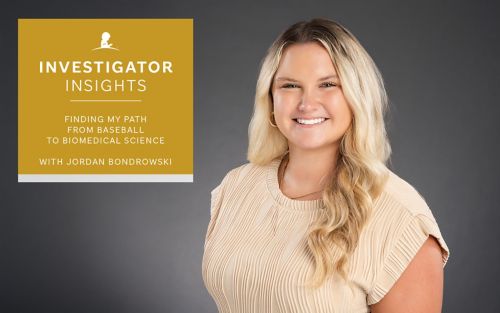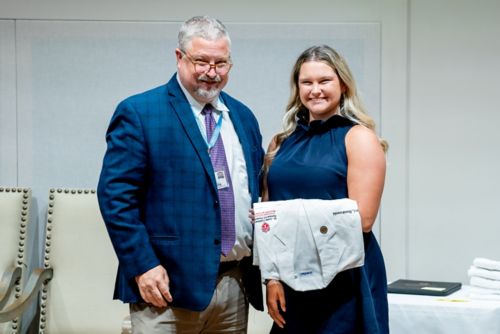St. Jude Family of Websites
Explore our cutting edge research, world-class patient care, career opportunities and more.
St. Jude Children's Research Hospital Home

- Fundraising
St. Jude Family of Websites
Explore our cutting edge research, world-class patient care, career opportunities and more.
St. Jude Children's Research Hospital Home

- Fundraising
Finding my path from baseball to biomedical science

Jordan Bondrowski, a St. Jude graduate student conducting research in the laboratory of Kiel Neumann, PhD, Radiology, was inspired early in life by how sports can motivate giving back to others.
I’ve had many mentors and inspirations in my journey to becoming a graduate student at St. Jude. From high school science teachers to researchers in the labs I now call home, so many people have made an impression on me. However, the catalyst to my career came from an unlikely source: an All-Star baseball player.

11-year-old Jordan and the baseball that inspired her to a career giving back to others.
I was 11 years old the first time I felt like I could make a difference in cancer research. I had gone with my dad to a Philadelphia Phillies game with tickets that were his Father’s Day gift. We were sitting close to the field up the third base line when Freddie Freeman of the visiting Atlanta Braves hit a ball deep to centerfield. In a moment of serendipity, the broadcasters for the game were seated in the outfield bleachers, and play-by-play voice Tom McCarthy called the action while reaching his glove out and catching the home run. Pressured by a raucous crowd, he honored the tradition of throwing a visitor’s home run ball back onto the field. As the ball girl retrieved it, my eyes caught my dad’s, and with an approving nod, I ran to the front row, and she gave me the ball, a memory to highlight a special day for the two of us.
The next morning, a Philadelphia sports radio station started talking about that home run ball, wanting to track it down to give it back to the announcer. They even offered $500. Hearing this on his drive to work, my dad called home so my mom could wake me up and ask what I wanted to do. I was surprised; I was raised by great parents who taught me the value of giving to others, so I knew the right thing to do.
At 11, I didn’t need $500. What I wanted was to give the reward money to breast cancer research. There was a lot of visibility for Breast Cancer Awareness Month, and we received pink ribbons at school and learned about the impact of breast cancer. I’d already been selling homemade Rainbow Loom bracelets outside of my house and donating the money. In my mind, even a few hundred dollars could help cure cancer.

Jordan and her family remain avid Philadelphia Phillies fans
The story of how I gave the ball back and donated the money was embraced by Phillies fans, but the experience also gave me something more important: a sense that I could play a role in supporting cancer research. Even though I didn’t know what being a scientist really meant at that point, I knew I wanted to contribute to finding answers.
Not long after, my aunt was diagnosed with metastatic cancer, melanoma that had spread to her liver and abdominal cavity. She had a stroke in May, and by July, she was gone. It happened so quickly that it was hard to understand how one cell could move through the body and change everything. Watching how cancer disrupted not just her life, but the lives of my whole family, made me realize how deeply I wanted to help stop other families from experiencing that kind of loss.
In high school, I began to see a way forward. Biology and chemistry classes opened my eyes to the idea that I could not only support cancer research through fundraising, but I could also be directly involved in making a difference through science. I joined an undergraduate research lab at the University of Alabama, where I studied the structure and function of antibiotic resistant enzymes. I first encountered St. Jude through the Pediatric Oncology Education program. This program brings undergraduate students to St. Jude for the summer for a research-and-learning experience. I worked with glioma cell lines, and my love for cancer research truly blossomed. That experience confirmed I wanted to make this my life’s work.

Jordan receiving her white laboratory coat during a ceremony at the St. Jude Graduate School of Biomedical Sciences
After my transformative experience in the Pediatric Oncology Education program, St. Jude seemed like a natural fit when I wanted to pursue a graduate degree. Now, as a second-year PhD student in the St. Jude Graduate School of Biomedical Sciences, I’ve joined the lab of Kiel Neumann, PhD, in the Department of Radiology. My project is to use a type of imaging called positron emission tomography to track CAR T cells, a type of immunotherapy, as they move through the body and interact with tumors. We plan to radiolabel the cells so we can study their movement. This approach could be very informative about how CAR T–cell therapy works, or struggles, in diseases such as childhood solid tumors.
The best part of graduate school so far has been the mentorship. I’ve been fortunate to have mentors who are generous with their time and guidance. The principal investigator of my lab, Dr. Neumann, has shown us not only how to design experiments but also how to think about the bigger picture of research — from writing grants to managing a lab. Those experiences remind me that mentorship isn’t just about science; it’s about helping the next generation believe they can succeed. One day, I hope to pay that forward.
Beyond graduate school, there are many open paths, and I’m not exactly sure yet which one I’ll take, but I do know that I want my work to matter — not just in the lab, but in the lives of patients and families. Every day I walk through the halls of St. Jude, and I see children and families holding onto the possibility of better outcomes. That hope is what drives me. The graduate school has given me the chance to contribute through hands-on research and a voice in shaping the program itself. It still amazes me that I get to be here, surrounded by people who believe in the power of discovery. That I can do this, and through every action, I can make an impact.






